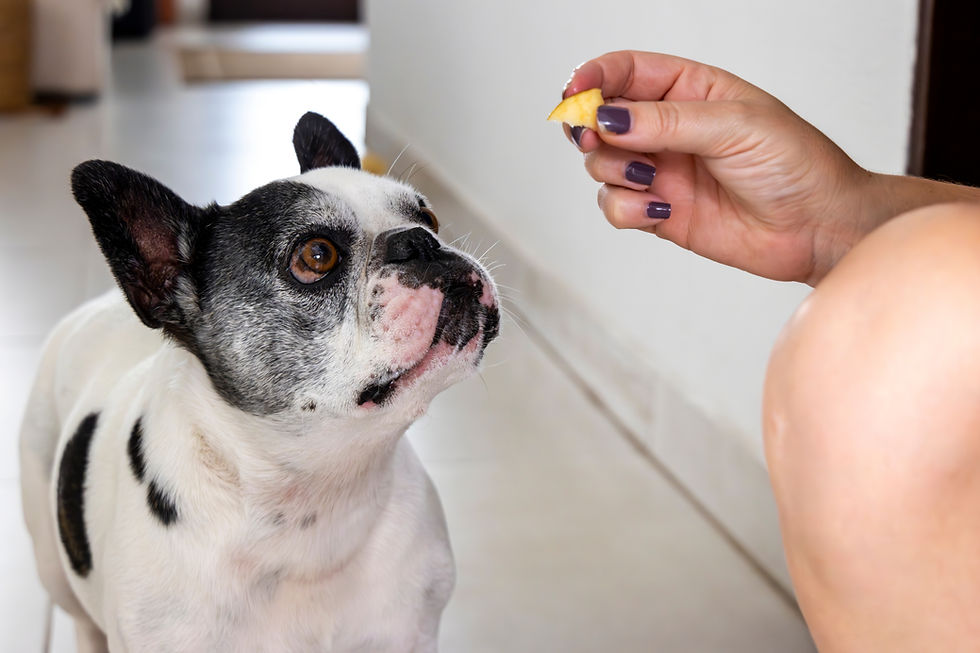The Power of Consent to Touch in Dog Training – A Journey from Fear to Trust
- heathergi85
- Oct 10, 2024
- 5 min read

Recently, I worked with a rescue dog who had a particularly troubled past. This sweet dog had experienced repeated instances of being physically moved and handled against his will in his previous home. Over time, this created a deep fear of being touched, moved, or even approached. His anxiety manifested in some common but challenging behaviours, including resource guarding random items, showing signs of stress when anyone tried to move him, and even reacting aggressively toward the resident dog if she so much as shifted near him.
Two weeks after moving to a foster home, this poor dog was still displaying the same fear-based behaviours. His foster family was concerned and understandably heartbroken to see him so tense. He would growl and stiffen up if he thought someone was going to move him, and his fear even escalated into full-blown resource guarding. The foster mum told me he always seemed sad, like he was carrying the weight of his past with him everywhere.
That’s when I introduced the concept of a consent to touch protocol.
We started working on a few simple behaviours designed to help him feel in control of his space and movement. Instead of forcing him to move or reaching in to handle him when he was anxious, we taught him behaviours that encouraged him to choose to move. Over the course of one week, his transformation was nothing short of miraculous. The foster mum was amazed to see a sparkle return to his eyes and said that, for the first time, he had started to look like a happy dog again. His sad demeanour gave way to a visible sense of trust and comfort.
This is the power of consent to touch.
What is Consent to Touch with Dogs?
At its core, consent to touch in dogs is about giving them a choice when it comes to physical interaction. Just like humans, dogs have personal boundaries. When these boundaries are consistently violated—such as being physically moved or touched against their will—it can lead to stress, anxiety, and fear-based behaviours. Consent to touch is a gentle approach where the dog gets to “say yes” to being touched or moved, rather than having it forced upon them.
This doesn’t mean you can never touch or guide your dog, but it’s about creating a partnership where the dog feels safe and in control. It’s especially important for dogs with histories of trauma or fear, but it’s beneficial for all dogs, as it builds trust and strengthens the bond between human and dog.
Why Is Consent to Touch So Important?
When dogs are given a choice in their interactions, their stress levels drop. They begin to trust that they won't be forced into uncomfortable situations, and this trust helps them relax. This sense of safety is especially important for rescue dogs who may have experienced a lot of instability and negative handling in the past.
Here’s why this method can make such a big difference:
Reduces Fear and Anxiety: By respecting a dog's boundaries, they no longer feel the need to be on guard or defensive, which leads to a reduction in fear-based behaviours.
Builds Trust: Dogs learn that their human will listen to them. They feel heard, respected, and, most importantly, safe.
Improves Cooperation: When a dog feels safe, they are more willing to cooperate. Instead of needing to be physically moved, they will respond to cues or signals.
Prevents Escalation: Many aggressive behaviours, such as growling or snapping, are a dog’s way of saying “no” when they feel their boundaries are being pushed. By respecting their "no," we can prevent these behaviours from escalating.
How Consent to Touch Can Help Problem Behaviours
Consent to touch is not just about avoiding negative interactions; it’s about empowering the dog and helping them make positive choices. Here’s how it can directly address some common problem behaviours:
Resource Guarding: A dog that guards objects is often reacting out of fear of losing control. By giving the dog the choice to move away from the object or engage voluntarily, we remove the need for defensive behaviour.
Fear of Being Moved: If a dog is afraid of being physically manipulated, they might resist or lash out. Teaching the dog to move on cue or voluntarily reposition themselves helps them feel safe without the need for force.
Aggression Toward Other Dogs: Sometimes, when a dog is feeling tense or insecure, they may redirect aggression toward another dog. By creating a secure environment where they feel in control of their space, this type of anxiety-driven aggression can lessen.
Simple Ways to Implement Consent to Touch
So, how do you start using consent to touch with your dog? Here are some easy steps you can take to put this into practice and foster a stronger, more trusting relationship:
Wait for Your Dog to Interact with You: Stop initiating contact all the time and give your dog the space to approach you. You might be surprised to find they initially keep their distance. That’s perfectly normal. Once they learn that affection happens on their terms, they’ll likely become much more affectionate and seek out interaction more often.
Ask Your Dog for Permission to Pet: When your dog does approach, don’t immediately start petting them. Instead, offer your hand by lowering it in front of them. If they nudge, lick, rub against, or paw at your hand, they’re saying “yes.” You can then go ahead and stroke them. However, if they simply stand there, look away, lick their lips, or growl, that’s a clear “no.” Respect that. For more details on understanding your dog’s body language, see our blog post on the Canine Ladder of Communication and why it’s crucial to listen to your dog’s signals.
Respect the "No": If your dog says “no” by showing disinterest or stress, leave them be. This is where the trust begins—when your dog learns that they can say “no” and it will be respected, they’ll feel much more secure.
Check In During the Interaction: If your dog has said “yes,” stroke them once or twice, then stop and ask again by pausing and reoffering your hand. This gives them the chance to continue the interaction or walk away. It ensures the petting is always on their terms and that they remain comfortable.
End the Interaction on a Positive Note: Use a phrase like “OK, no more” in an upbeat voice to signal the end of the interaction. This provides a clear cue for your dog to disengage and relieves any pressure they might feel. It’s a pressure release for them to step away and relax.
Trust Will Grow: Once your dog knows they are in control of when and how they are touched, you’ll notice their “yes” responses become more enthusiastic and obvious. Over time, they’ll seek you out more often for affection, because they feel safe and secure, knowing their boundaries will be respected.
By following these steps, you’ll help your dog feel empowered, respected, and safe in their interactions with you. When dogs know they have a choice, they are far more likely to engage positively and show affection because they want to, not because they have to.
A Journey Toward Trust
The story of this rescue dog is just one of many that highlights how powerful a consent-based approach can be. In just a short time, he went from a fearful, guarded dog to one who could trust again, showing off that sparkle in his eyes that had long been absent.
If your dog is struggling with fear, anxiety, or stress-based behaviours, implementing a consent to touch protocol could be the key to unlocking their potential for trust and happiness. Not only will you see a reduction in problem behaviours, but you’ll also witness the growth of a bond built on mutual respect and understanding—a bond that can truly bring out the best in both of you.
Remember, trust isn’t something we demand from our dogs. It’s something we earn by listening, respecting, and working alongside them.
_edited_j.jpg)





Comments